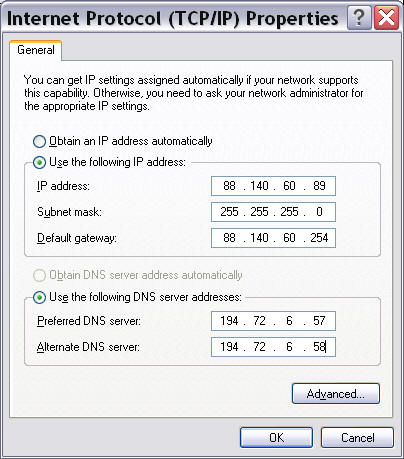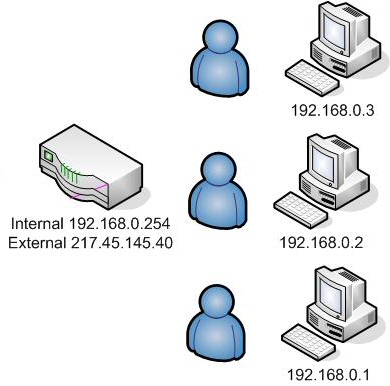Broadband Routers and Networks
This page deals with wired Broadband Routers but actually contains useful information for any networking set-up, explained in as simple terms as I know how. If you are having issues with your wireless router then you may wish to have a look here as well, but the information on this page may also be applicable.
Firstly here are a few pointers for those of you who are stuck:
Router - The router is a modem or network card with a little computer and network card stuck to the other end of it. It has two IP addresses, one for the modem/network card on the internet and the other for your internal network. (The same applies for wireless routers only your internal network card is a wireless card) You will be able to surf the internet when your router has been given the correct username and password for your ISP and it gets an internet address to the modem AND has an internal network address which your PC has connected to with its own IP address.
IP Address - On the client machine (i.e. the computers you want to use to surf the web) this will usually be automatically assigned along with the Subnet Mask and Default Gateway.
Default Gateway - This is the IP Address of the router and is by default something like 192.168.1.1 for most routers or 192.168.2.1 or 192.168.0.1 for some others. It is the default first place to go for any traffic outbound to the internet from the computers wishing to surf - known as a first hop-.
Subnet Mask This will usually be 255.255.255.0 for most users. If you want a detailed explanation you will have to read on....
We are going to start at the beginning as it is always important to know the theory...
TCP/IP Networking is dependent upon every device on the network having an IP (Internet Protocol) address. An IP address is made up of 4 numbers, each being an eight bit value made up of 8 1's and 0's (bits). These numbers appear in the form x.x.x.x where x= 0-255, for example 192.168.0.1.
Each part of the Internet, whether in another country or whatever, is assigned a range of these numbers and each part knows where in relation each other part is and so traffic can be 'routed' from one part to another extremely effectively allowing us all to seamlessly communicate. 192.168.x.x is a special range of numbers put aside for 'Class C' internal networking (see later in the text for what Class C means) and has no users on the Internet.
An IP address allows all of the information sent to you to be routed to your host (a host is a device with an IP address on the network or internet). Your computer can obtain an address in one of two ways. Firstly you can go into the network configuration pages and give it a specified address, as below:

As you can see there are a number of values to consider concerning the configuration of an IP address. The IP address itself, the subnet mask and the default gateway are all integral to your computers ability to surf the Internet. Whether you are using a modem, wireless LAN card or a network interface card, it will be assigned an IP address, either manually or automatically, with DHCP. The subnet mask is what tells your computer what is on your own network and what is not. It does this by telling your computer how big your network is.
The Windows IP Address Configuration Panel
In the Example shown, the address is what is referred to as a 'Class C' address. This means that, as all of the values are at their maximum except the last, there are up to 256 hosts. If the subnet mask was 255.255.0.0 it would be a 'Class B' subnet allowing for 256 'Class C' subnets and so 65536 hosts. If I am on a Class C subnet with 256 hosts, only the last value in the x.x.x.x IP address can change before traffic will use the default gateway to get to the address it seeks:

In the example above, all addresses in the range 192.l68.0.x will be treated as internal because the subnet mask is 255.255.255.0 indicating a class c subnet which means that the internal hosts will send any packet that is not addressed to 192.168.0.x through the default gateway which is the router at 192.168.0.x. A subnet of 255.255.255.255 would therefore indicate it is the only address in the subnet. It should be noted that there is a convention for IP address. For the first value at the left, Class A addresses are 0-127, Class B are 127-191 and Class C are 192-255.
The alternative, as is more common and convenient, is that an address is assigned automatically by something called DHCP. DHCP (Dynamic Host Configuration Protocol) works by your system sending out a signal to everything else on the network (a multicast broadcast) that is has no address and any DHCP server device it reaches will respond to that request by leasing an IP address to that client for some predetermined period. For example if you are using the inbuilt DHCP server of Windows to share a network connection it will automatically use the address 192.168.0.1 as the DHCP server machine (the machine sharing the connection and handing out the IP addresses.) Each client that is configured to automatically receive an address (which is the default setting) will receive an address in the range 192.168.0.x and the default gateway will be 192.168.0.1 which is the 'way out' of the network to everywhere else and should always be the address of the connection to the internet. DHCP automatically provides as much networking information as you have configured the server with and can include the IP address, subnet mask, default gateway, DNS servers (for obtaining the IP address of a domain name like microsoft.com) and a host of other features. As long as you have the aforementioned four pre=requisites - IP address, subnet mask, default gateway and DNS server(s) you should be able (if you have connectivity) to surf to internet websites.
This is, however only taking into account your internal network. A router is a router because it routes information from one connection to another, or between three or more interfaces. Your broadband router has a connection to the internet via ADSL or Cable etc. and so it has either another network card or an ADSL modem on the internet. This interface, whether it be modem or network card, must also have an IP address, an IP address assigned by the Internet Service Provider (ISP) who routes the internet data to and from your routers external interface address. The example above shows this to be 217.45.145.40 which is a BT ADSL business address and can be looked up as such. BT have been assigned a range of addresses by the internet administrators and resell these addresses onto their clients. If your router has the correct username and password and is configured for the right type of line it will receive an IP address and then route the data it receives from each interface - i.e. the internet and your personal network - from side to side allowing you to browse, download and email etc. The external address is most likely obtained from BT by DHCP but your router will prevent the internet DHCP requests from penetrating your network leaving your own routers DHCP messages undisturbed. The external IP address must be one that your ISP is expecting as all of their routers are configured to route messages according to different addresses and if your routers external IP is unexpected it will not accept the correct incoming traffic.
A note for AOL users:
If you are having difficulty with browsing some sites such as Microsoft.com?, check the ADSL router MTU setting under WAN set-up and change it from 1492 to 1400 which should solve the problem.